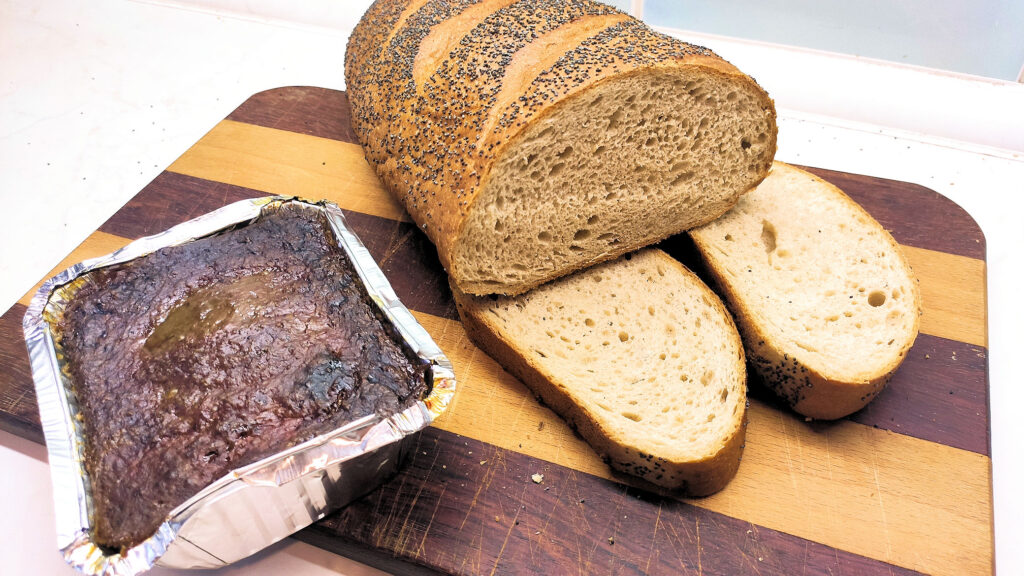If you're my age (if you're a boomer), you probably remember trips to the bakery for half a loaf of French bread from your school days. If the waves were high, it was hollowed out and filled with cream puffs.
This version has been slightly modernised by replacing about 1/3 of the white flour with spelt - it adds flavour and a bit more fibre, and spelt has good baking properties.
WATCH THE RECIPE FOR HOMEMADE OLD-FASHIONED FRENCH BREAD ON VIDEO HERE: https://youtu.be/P4rp4UIIjV8
An old-fashioned French loaf, but with a little spelt for texture and flavour. Learn some of the baker's tricks.
Ingredients for a homemade old-fashioned French loaf
225 g Wheat flour with 12% protein
120 g wholemeal spelt flour - coarsely or finely ground
12 g gluten (can be replaced with wheat flour)
8 g salt
9 g Baking enzymes (can be replaced with wheat flour)
20 g dried wheat sourdough starter (can be replaced with wheat flour)
8 g dry yeast (or 25 g fresh yeast dissolved in water)
7 g Sugar
10 g canola oil
255 g cold water
Blue poppy seeds or White poppy seeds for the top
If you do not use gluten, baking enzyme and dried sourdough starter, the total amount of wheat flour is 265 grams
Method
Mix the dry ingredients in the mixing bowl. Add the water and oil and let the mixer run at low speed for a few minutes. Then increase to medium speed (or slightly below) for 12-14 minutes until the dough is shiny and has a temperature of 27-28°. The dough will be quite firm, as it should be.
Stretch the dough (stretch and fold like sourdough), let rest on the table for 15 minutes, covered with plastic, for example.
Stretch and fold the dough again and let it rest for 10 minutes
Shape the dough into a French loaf - it needs to be tightened to give the most beautiful rise:
- Turn the lump of dough over and press the air out of it with your hands. Pull the top 1/3 down and the bottom 1/3 up.
- Roll it into an oblong - and roll the ends thinner than the centre. Fold the thin ends over the centre.
- Flatten the dough again and roll it from the top down into the shape of a loaf - you should sort of "pull" on it as you roll it up so that you feel you are tightening the surface.
- Place the bread on baking paper on a baking tray or, even better, without baking paper on a greased perforated tray.
Brush or spray with water and sprinkle with poppy seeds. Score at an angle (not too deep cuts)
Place a container of boiling water next to the bread and cover with a large plastic box to create a warm, moist space.
It should rise like this for 40 minutes.

Heat the oven to 250°, fan off, well in advance. Place a small roasting tin with granite chips or lava stones in the bottom and let it heat up - preferably for 30 minutes.
Place the tray inside, pour 1 dl boiling water over the shards (watch out for steam, use an oven glove) and quickly close the door. Switch to hot air and 190°.
After 4 minutes, remove the shards. After another 11 minutes, flip the tray over to bake evenly (the back of the tray to the front). Bake for a further 10 minutes, opening the oven to let out any remaining steam and then bake for 5-10 minutes, keeping an eye on the colour. You can let steam out of the oven when checking the colour of the bread. Total baking time 30-35 minutes.
Cool on a wire rack.
Watch this video to get the full benefit of the baking tricks from this recipe:







4 Comments
Hi Laus
What if I don't want to use spelt, should I just use 120g more wheat flour?
Greetings Mikkel
Yes, you can. You can choose to use 130g instead of 120g, as spelt flour absorbs more liquid
Can you use half of each type of flour?
Super delicious loaf
Yes, you can do that. But be aware that spelt flour absorbs more liquid and doesn't build as stable a gluten structure as wheat flour. You should bake it in a mould (as in the recipe)